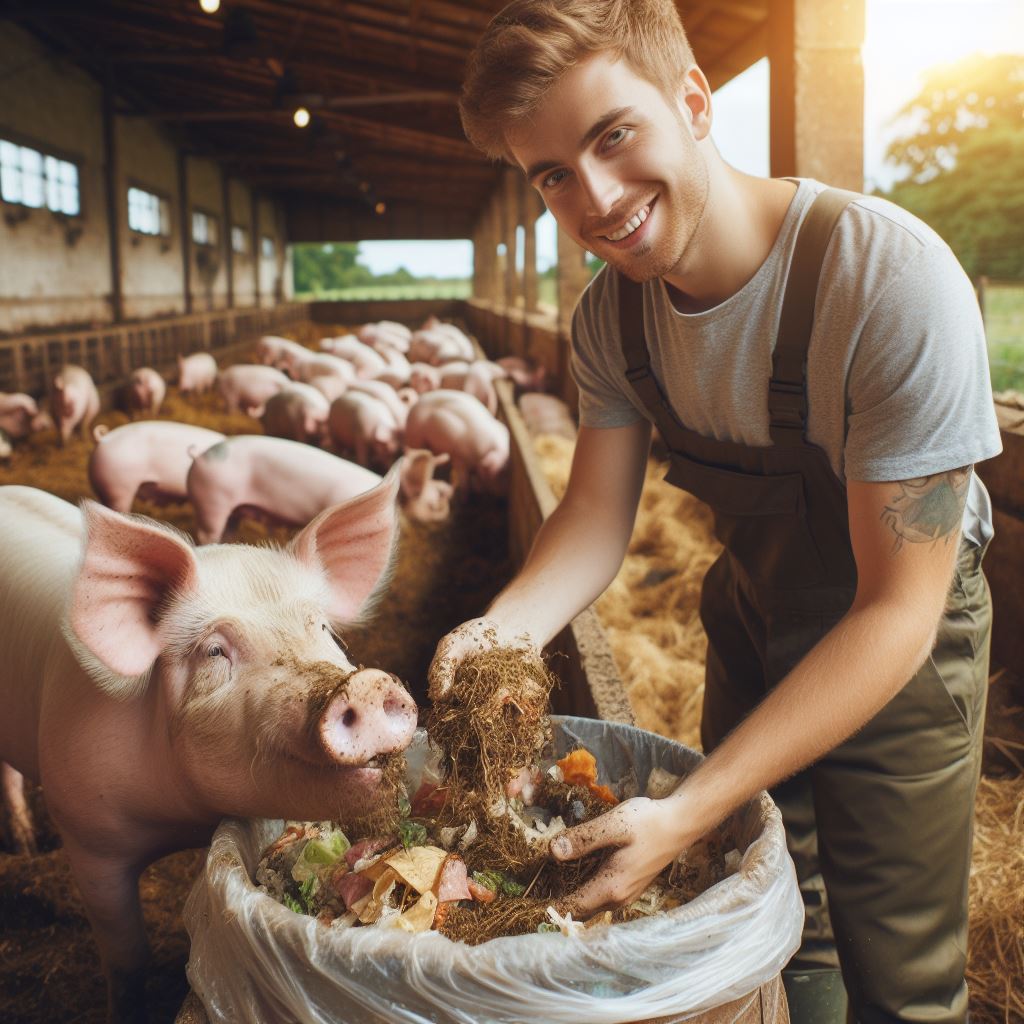Introduction
In today’s farming landscape, innovations in swine welfare are revolutionizing how we care for our porcine companions.
Recognizing the pivotal role of swine welfare in modern agriculture, these breakthroughs aim to elevate the well-being of our swine populations.
Why Swine Welfare Matters
- Ethical Responsibility: Treating animals with compassion aligns with ethical farming practices.
- Healthier Livestock: Ensuring swine well-being enhances overall herd health and productivity.
- Improved Product Quality: Content and stress-free pigs contribute to superior meat quality.
- Sustainable Farming: Ethical and healthy swine farming practices support long-term environmental sustainability.
- Consumer Demand: A growing awareness of animal welfare prompts consumer preference for responsibly raised pork.
Embracing innovations in swine welfare isn’t just a choice; it’s a commitment to a more humane, sustainable, and efficient future in agriculture.
Current Challenges in Swine Welfare
- Limited space: Swine are often confined to small stalls, hindering their natural behaviors.
- Lack of environmental enrichment: Pigs need stimulation to prevent boredom and aggression.
- Health issues: Overcrowding can lead to the spread of diseases and infections among swine.
- Lack of proper ventilation: Poor air quality can cause respiratory problems in pigs.
- Handling and transportation: Rough handling and inadequate transportation methods can cause stress and injuries.
- Inappropriate housing systems: Confinement in gestation crates and farrowing crates restrict pigs’ movement.
- Lack of pain management: Surgical procedures such as castration and tail docking are often performed without pain relief.
Importance of addressing these challenges for the well-being of pigs and the industry as a whole
The importance of addressing these challenges for the well-being of pigs and the industry as a whole:
- Ethical considerations: Ensuring swine welfare is not only morally right but also meets societal demands for compassionate farming practices.
- Animal health and productivity: Providing a stress-free environment improves immune function and reduces disease incidence, leading to healthier and more productive animals.
- Consumer perception and demand: Concerns for animal welfare are increasing among consumers, and addressing these challenges can enhance consumer trust and demand for pork products.
- Efficiency and profitability: Healthy and content swine are more efficient in utilizing feed, leading to cost savings and improved profitability for farmers.
- Compliance with regulations: Adhering to welfare standards ensures compliance with animal welfare laws and regulations, avoiding legal implications and penalties.
- Sustainable farming practices: Promoting swine welfare aligns with the principles of sustainability, as it reduces resource wastage and supports the long-term viability of the industry.
Innovations in Swine Welfare
- Enriched housing systems: Implementing larger pens with bedding material and objects for exploration and play enhances swine well-being.
- Improved ventilation systems: Installing proper ventilation systems in swine facilities ensures better air quality and respiratory health.
- Group housing for sows: Transitioning from individual stalls to group housing allows sows to socialize and move freely during gestation.
- Pain management protocols: Using pain relief techniques during procedures like castration and tail docking minimizes discomfort for the pigs.
- Training programs for handlers: Educating farm workers on proper handling techniques reduces stress and injuries during transportation and daily operations.
- Precision livestock farming technologies: Utilizing sensors and monitoring systems allows farmers to assess individual pig behavior and welfare in real-time.
- Research and development: Continued research in swine welfare facilitates the discovery of new innovations and best practices in the industry.
Therefore, addressing the challenges in swine welfare is crucial for the well-being of pigs, the sustainability of the industry, and meeting consumer demands.
By implementing innovative solutions, such as enriched housing and pain management protocols, we can improve the lives of swine and ensure a thriving and responsible swine industry.
Read: Organic Feed for Healthy Pigs
Technological Advancements
Technology plays a crucial role in improving swine welfare by introducing innovative solutions that enhance the well-being of pigs and increase farm efficiency.
Let’s explore some of the technological advancements being implemented in swine welfare:
Automated Systems for Monitoring and Managing Pig Health
Automated systems have revolutionized the way pig health is monitored and managed on farms.
- These systems use sensors placed in the barn to collect real-time data on various parameters.
- Parameters such as temperature, humidity, air quality, and ammonia levels can be monitored continuously.
- Any deviation from optimal conditions triggers alerts for farmers to take immediate action.
Such technology helps prevent disease outbreaks and provides early intervention, ensuring the well-being of the swine population.
Behavior Monitoring and Analysis
Understanding pig behavior is essential for identifying stress, disease, or discomfort.
- New technological advancements allow for the continuous analysis of pig behavior patterns.
- Vision systems and computer algorithms can detect abnormal behaviors such as aggression or lameness.
- Alerts are then generated to inform farmers about potential issues, enabling early intervention.
By closely monitoring pig behavior, farmers can address welfare concerns promptly and provide appropriate care.
Comfort Systems for Pigs
Providing optimal comfort conditions improves the overall welfare of pigs, resulting in better productivity.
- Technological innovations have introduced temperature-controlled barns to ensure pigs’ thermal comfort.
- These barns use ventilation and cooling systems that automatically adjust based on temperature and humidity.
- The flooring systems have also been improved to enhance the pigs’ comfort and reduce the risk of injuries.
Pigs raised in comfortable environments experience less stress, improved health, and higher growth rates.
Transform Your Agribusiness
Unlock your farm's potential with expert advice tailored to your needs. Get actionable steps that drive real results.
Get StartedFeed and Water Monitoring
Proper nutrition and access to clean water are vital for the welfare and performance of pigs.
- Smart feeding systems ensure precise control over feed distribution and consumption.
- These systems can track individual pig feeding patterns and adjust the ration accordingly.
- Water monitoring systems detect water quality issues and ensure a continuous supply of fresh water.
By optimizing feed and water intake, these technologies contribute to the well-being and productivity of the swine herd.
Data Analytics and Management
The vast amount of data collected by these technological advancements can be leveraged through advanced analytics.
- Data analytics help identify trends, patterns, and correlations related to pig health and behavior.
- It enables farmers to make data-driven decisions for effective management and intervention.
- Farmers can also access real-time information remotely, allowing for instant response and better farm management.
By harnessing the power of data, swine farmers can continually improve animal welfare and optimize their operations.
Most importantly, technological innovations in swine welfare have revolutionized the way we care for pigs on farms.
Automated systems for monitoring and managing pig health, behavior, and comfort enable early intervention, prevent disease outbreaks, and enhance overall farm efficiency.
These advancements contribute to improved animal welfare, ensuring pigs are raised in optimal conditions, resulting in healthier and more productive herds.
By embracing these technologies, the swine industry continues to progress in providing the best possible care for its animals.
Read: Sustainable Pig Farming Techniques

Environmental Enhancements
When it comes to swine welfare, environmental enhancements play a crucial role in ensuring the well-being of pigs.
By examining the various enhancements being introduced in swine production, we can understand how these changes positively impact pig welfare.
Enrichments in Swine Production
Enrichments, such as straw, platforms, and toys, are being increasingly used in swine production to provide a more stimulating environment for pigs.
These enhancements go beyond the basic needs of food, water, and shelter, allowing pigs to engage in natural behaviors.
Straw, for instance, provides pigs with a material to root and forage in, replicating their natural instinct to dig for food.
By allowing pigs to engage in such behaviors, they experience lower stress levels and improved overall welfare.
Platforms are another important environmental enhancement in swine production.
They provide pigs with raised surfaces where they can socialize, explore, and rest.
These platforms mimic the natural terrain, promoting exercise and muscle development in pigs.
Moreover, pigs on platforms have better access to their feed and water, reducing competition and stress during feeding times.
Additionally, toys are being introduced into swine production as a means to promote play and mental stimulation among pigs.
Play is an essential part of a pig’s natural behavior, and toys provide them with the opportunity to express their playful instincts.
Not only do these toys alleviate boredom, but they also reduce aggressive behaviors and stress among pigs.
Promoting Natural Behaviors
Environmental enhancements in swine production aim to promote natural behaviors that pigs exhibit in their wild counterparts.
By providing pigs with materials, platforms, and toys, they can engage in behaviors like rooting, socializing, exploring, and playing, which are essential for their physical and mental well-being.
Showcase Your Farming Business
Publish your professional farming services profile on our blog for a one-time fee of $200 and reach a dedicated audience of farmers and agribusiness owners.
Publish Your ProfileRooting, for example, allows pigs to express their natural instinct to dig for food.
When given access to straw, pigs can carry out this behavior, facilitating their physical and mental stimulation.
Additionally, the provision of platforms allows for socializing and exploration, promoting healthy social interactions among pigs.
Toys, on the other hand, encourage playfulness in pigs.
Play is not only a fun activity but also serves as a coping mechanism for pigs to release stress.
By providing toys that stimulate their curiosity and playfulness, pigs can divert their attention from negative behaviors and reduce overall stress levels.
Reducing Stress and Enhancing Welfare
Environmental enhancements play a vital role in reducing stress levels among pigs and enhancing their overall welfare.
By allowing pigs to engage in natural behaviors and stimulating activities, the risk of stress-related issues is significantly minimized.
When pigs are provided with enrichments like straw, platforms, and toys, they experience less boredom and frustration.
This, in turn, reduces the occurrence of aggressive behaviors, such as tail-biting and fighting, which can arise from stress and boredom in a barren environment.
Furthermore, the ability to engage in natural behaviors reduces the prevalence of stereotypic behaviors, such as excessive chewing or biting on pen fixtures.
These behaviors are often manifestations of stress and frustration.
When pigs have access to a stimulating environment, they are less likely to develop such harmful behaviors, leading to improved welfare.
In essence, innovative environmental enhancements in swine production, such as straw, platforms, and toys, have proven to be effective in promoting natural behaviors, reducing stress, and enhancing overall welfare.
These advancements not only cater to pigs’ physical and mental needs but also contribute to creating a more humane and sustainable swine industry.
Read: Managing Pig Health: Disease Control
Nutritional Manipulation
Swine nutrition plays a crucial role in ensuring the welfare of pigs.
Over the years, advancements in swine nutrition have led to better outcomes in terms of pig health and overall welfare.
Let’s explore some of the innovative developments in this field.
Advancements in Swine Nutrition
Improved understanding of swine nutritional requirements has paved the way for better welfare outcomes.
Researchers and nutritionists have focused on formulating diets that meet the specific needs of pigs at different stages of their lives.
Development of New Feed Formulations
In recent years, significant progress has been made in the development of feed formulations for swine.
These formulations are designed to provide the essential nutrients that promote pig health and well-being.
The inclusion of high-quality protein sources, minerals, and vitamins in swine diets has been shown to enhance growth and reduce the risk of diseases.
Additionally, specialized diets have been formulated to address specific health conditions, such as reducing the incidence of gut disorders and optimizing piglet growth.
Supplements for Improved Pig Health
To further enhance pig welfare, researchers have focused on developing nutritional supplements that provide additional benefits.
These supplements are often enriched with natural additives, such as probiotics, prebiotics, and organic acids, which promote gut health and optimize nutrient absorption.
Supplements fortified with antioxidants and immune-boosting ingredients have also been introduced to improve the overall health and resistance of pigs against common diseases.
Precision Feeding Techniques
Precision feeding has emerged as a game-changer in swine nutrition.
This technique involves tailoring individual diets to meet the specific needs of each pig, considering factors such as age, weight, genetics, and health status.
By utilizing precision feeding, nutritionists can optimize growth rates, reduce feed wastage, and improve the overall welfare of pigs.
This approach enables a more efficient utilization of nutrients while minimizing the environmental impact of pig production.
Precision feeding techniques utilize advanced technologies, such as computerized feeders and individualized diet formulations, to deliver the right nutrients in the right quantities at the right time.
This personalized approach ensures that each pig receives the optimum nutritional support required for its well-being.
Environmental Sustainability
Innovations in swine nutrition also focus on promoting environmental sustainability.
Nutritional manipulations can contribute to reducing the environmental footprint of pig production by enhancing nutrient utilization and minimizing nitrogen and phosphorus excretion.
Novel feed ingredients, such as by-products from the food and agriculture industries, are being explored as alternatives to traditional feed sources.
These sustainable feed options not only contribute to better swine welfare but also reduce the dependence on finite resources and help in waste valorization.
In fact, innovations in swine nutrition have significantly enhanced the welfare of pigs.
Advancements in feed formulations, the development of nutritional supplements, and the implementation of precision feeding techniques have all contributed to better pig health and growth.
Showcase Your Farming Business
Publish your professional farming services profile on our blog for a one-time fee of $200 and reach a dedicated audience of farmers and agribusiness owners.
Publish Your ProfileAs we continue to explore new ways to optimize swine nutrition, it is crucial to prioritize the well-being of the animals, reduce the environmental impact, and ensure sustainable pig production practices.
Read: Livestock Management: Diverse Animal Care
Handling and Transportation Innovations
In the swine industry, constant efforts are being made to improve the welfare of pigs at every stage of their lives.
One area that has seen significant advancements is in handling and transportation practices.
These innovations aim to minimize stress on pigs and ensure safe and comfortable transport.
Advancements in Handling Practices
Handling pigs can be a stressful experience for them.
Traditional methods involve physically moving pigs by using force or applying pressure, which can lead to fear and agitation.
However, low-stress handling techniques have emerged as a game-changer.
Low-stress handling techniques focus on understanding pig behavior and utilizing it to facilitate movement. Rather than using force, handlers use calm and patient approaches to guide pigs.
This reduces stress levels and allows pigs to move in a more natural and comfortable manner.
Technology has played a crucial role in helping handlers adopt low-stress techniques.
Video monitoring systems enable handlers to observe pig behavior closely, identify stressors, and make appropriate adjustments.
Real-time data analysis helps handlers refine their handling techniques and improve overall pig welfare.
Innovations in Transportation Designs
Transportation is another critical aspect of pig welfare.
Traditionally, pigs were loaded onto trucks without much consideration for their well-being during transit.
However, improved transportation designs have revolutionized this process.
The first innovation is the development of specialized transport vehicles.
These vehicles are designed to provide ample ventilation, temperature control, and comfortable flooring.
The use of non-slip materials ensures that pigs have secure footing, preventing injuries during transportation.
Additionally, the use of hydraulic or pneumatic suspension systems has greatly improved the ride quality for pigs.
These systems absorb shocks and vibrations, reducing the stress caused by uneven road surfaces.
Pigs experience less fatigue and discomfort during transport, ultimately benefiting their welfare.
Advanced monitoring systems have also been integrated into transportation designs.
These systems monitor temperature, humidity, and air quality inside the vehicles, ensuring optimal conditions for the pigs.
Any deviations from the desired parameters trigger alerts, allowing immediate corrective actions to be taken.
Impact on Pig Welfare
The adoption of low-stress handling techniques and improved transportation designs has had a significant impact on pig welfare.
The reduction of stress during handling and transport directly contributes to the overall well-being of pigs.
With low-stress handling, pigs experience minimal fear and anxiety, resulting in improved behavior and reduced aggression.
They are more likely to move smoothly and willingly, without the need for forceful interventions.
This not only promotes pig welfare but also enhances the safety of handlers.
Similarly, the use of advanced transportation designs ensures that pigs are transported in a safe and comfortable environment.
The reduction of stressors, such as vibrations, temperature fluctuations, and inadequate ventilation, minimizes the risk of transport-related injuries or illnesses.
Furthermore, these innovations have also led to a decrease in the number of non-ambulatory pigs, commonly known as “downer pigs.”
The improved flooring and suspension systems prevent pigs from losing their balance or sustaining injuries during transportation.
As a result, the occurrence of transport-related injuries has significantly reduced.
In short, handling and transportation innovations have transformed the swine industry by focusing on pig welfare.
Low-stress handling techniques and improved transportation designs have paved the way for safer and more comfortable journeys for pigs.
These advancements not only reduce stress-related injuries but also contribute to overall improvements in pig behavior and well-being.
Future Trends and Challenges
Potential Future Trends in Swine Welfare
- Automation and robotics can improve efficiency and reduce labor-related stress on swine farms.
- Genetic selection and breeding techniques can be employed to enhance the overall well-being of swine.
- Developing innovative housing systems that provide ample space and environmental enrichment for swine.
- Implementation of advanced monitoring technologies to assess the health and behavior of individual pigs.
- Exploring alternative feed ingredients and optimizing nutritional strategies to improve swine health.
- Utilizing precision farming techniques, such as sensor technologies, to enhance swine management practices.
Challenges in the Adoption of Swine Welfare Advancements
- Cost implications can pose a significant challenge for swine farmers when adopting new welfare innovations.
- The implementation of new technologies and practices may require substantial changes in farm infrastructure.
- Ensuring consumer acceptance of new welfare advancements can be influenced by cultural perceptions and preferences.
- Educating and training farmers to effectively utilize new technologies and management practices is crucial.
- Complying with regulatory standards and addressing potential animal welfare concerns is paramount.
- Managing the potential risks and unintended consequences associated with adopting new welfare advancements.
The Need for Continuous Research and Development
As swine farms strive to enhance welfare standards, continuous research and development are fundamental for the following reasons:
- Identification of novel tools and techniques that further aid in promoting swine welfare.
- Measuring the long-term impacts of welfare innovations on pig health, productivity, and overall well-being.
- Addressing knowledge gaps to better understand the behavioral and physiological needs of swine.
- Improving the cost-effectiveness and practicality of implementing welfare advancements on a larger scale.
- Staying proactive in identifying emerging welfare concerns and promptly finding adequate solutions.
- Collaborating with stakeholders to develop and refine welfare guidelines and standards.
In review, the future of swine welfare looks promising with the emergence of innovative trends and advancements.
Showcase Your Farming Business
Publish your professional farming services profile on our blog for a one-time fee of $200 and reach a dedicated audience of farmers and agribusiness owners.
Publish Your ProfileHowever, challenges related to cost, implementation, and consumer acceptance need to be carefully addressed.
Continuous research and development are essential to drive further improvements in swine welfare, ensuring the well-being of pigs and the sustainability of the swine industry.
Conclusion
Innovations in swine welfare play a crucial role in ensuring the well-being of pigs and the sustainability of the swine industry.
Technological advancements and best practices have been instrumental in improving swine welfare.
Throughout this blog section, we have discussed significant advancements in swine welfare, including the use of precision farming techniques, environmental enrichments, and improved housing systems.
These innovations have addressed key issues such as pig health, behavior, and overall welfare, resulting in enhanced productivity and reduced stress levels.
By implementing these advancements, the swine industry has seen positive outcomes, such as improved pig growth, reduced mortality rates, and better disease management.
Furthermore, these innovations have contributed to environmental sustainability, with reduced emissions and improved waste management systems.
It is imperative that the swine industry continues to invest in research and development to further improve swine welfare.
Efforts must be made to integrate technological advancements with best practices, ensuring the continuous enhancement of animal care and welfare standards.
Advancements in swine welfare are essential for the overall success of the swine industry.
These innovations not only benefit pigs by enhancing their well-being, but also contribute to the long-term sustainability of the industry.
As consumers become increasingly conscious about animal welfare, it becomes crucial for the swine industry to prioritize these advancements, maintain transparency, and meet consumer expectations.
By embracing technology and striving for continual improvement, the swine industry can ensure a bright and sustainable future while providing better care for its livestock.




